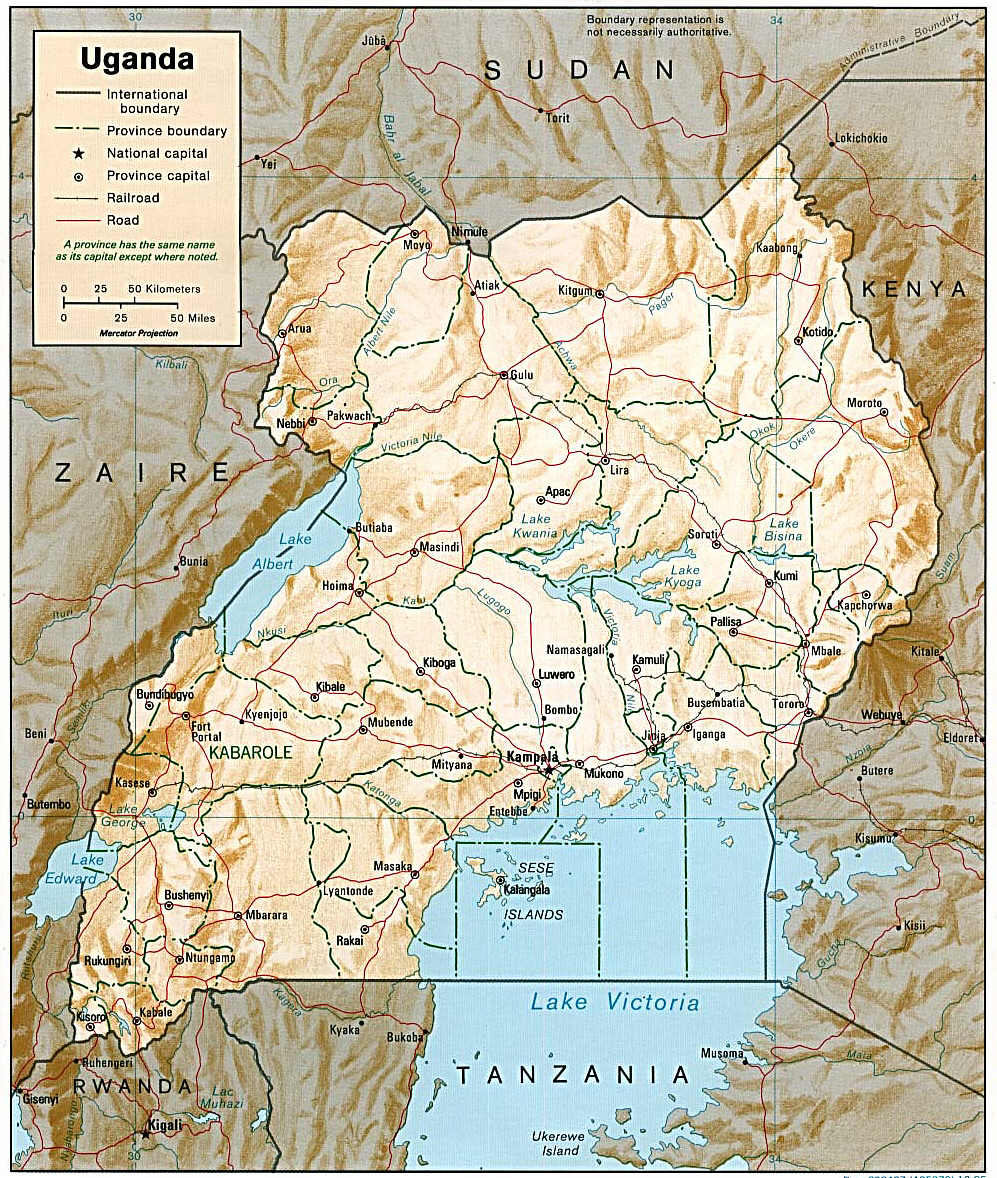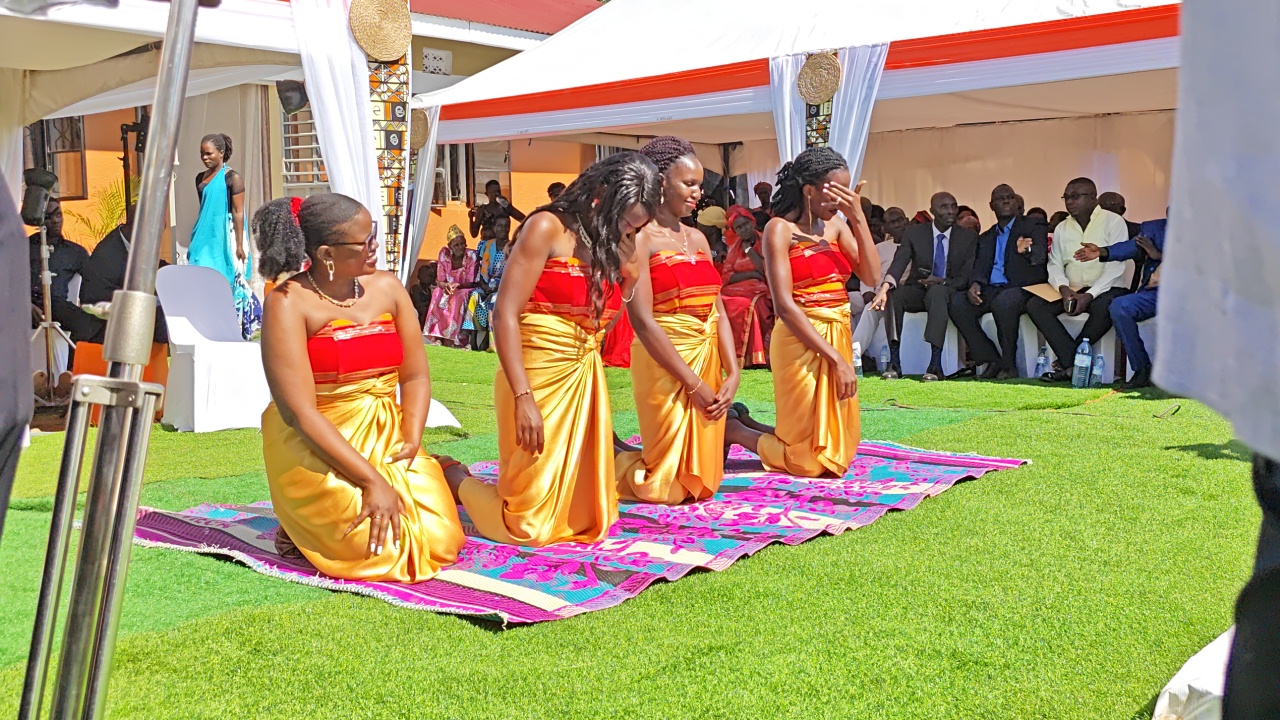|
Soroti–Dokolo–Lira Road
The Soroti–Dokolo–Lira Road is a road in Uganda, connecting the towns of Soroti in Soroti District, Dokolo in Dokolo District, and Lira in Lira District. Location The road starts at Soroti (population 49,452), the largest town in the Teso sub-region, Eastern Region of Uganda. It continues in a northwesterly direction, through Dokolo in Dokolo District, Lango sub-region, Northern Region, to end at Lira, in Lira District, a total distance of about . The coordinates of the road near Dokolo are 1°55'23.0"N, 33°09'28.0"E (Latitude:1.923056; Longitude:33.157778). Upgrading to bitumen In 2007, partly financed with a loan from the World Bank Group, the government of Uganda began improving the surface of this road to class II bitumen, with shoulders and drainage channels. Upgrading of the Soroti-Dokolo section began in May 2007. Work on the Dokolo-Lira section began a month later. The construction contract was awarded to China Roads and Bridge Corporation. The road works were c ... [...More Info...] [...Related Items...] OR: [Wikipedia] [Google] [Baidu] |
Soroti
Soroti is a city in Eastern Region, Uganda, Eastern Region of Uganda. It is the main city, commercial, and administrative center in Soroti District, one of the nine administrative districts in the Teso sub-region. Soroti city was immediately approved for operationalization ahead of schedule by the Parliament of Uganda in the Financial Year 2020/2021. History In the late Uganda–Tanzania War, Soroti suffered from lootings as well as mass killings committed by fleeing Uganda Army (1971–1980), Uganda Army troops. When the Uganda National Liberation Army (UNLA) and the Tanzania People's Defence Force's 7th Battalion captured the town as part of the Eastern Uganda campaign of 1979, they found it plundered and discovered the corpses of about 50 civilians. The local Radio Uganda station was left mostly undamaged, however, and was quickly broadcasting again. In the last phase of the Ugandan Bush War in early 1986, the area around Soroti became the site of heavy fighting. Rebelling ... [...More Info...] [...Related Items...] OR: [Wikipedia] [Google] [Baidu] |
New Vision
The ''New Vision'' is a Ugandan English-language daily newspaper. It was established in its current form in 1986 by the Government of Uganda. It is the flagship newspaper of the state-owned Vision Group, a multimedia conglomerate. Along with its privately-owned competitor, the ''Daily Monitor'', the ''New Vision'' is one of the two largest national newspapers in Uganda. History The ''New Vision'' traces its origins to the colonial era. Its institutional predecessor, the ''Uganda Argus'', was founded in 1955 as a British colonial government publication. Following Uganda's independence in 1962, the government of President Milton Obote retained the ''Uganda Argus'' as its official paper. After the 1971 coup, the government of Idi Amin renamed the paper the ''Voice of Uganda''. When Amin was overthrown in 1979, the succeeding government named it the ''Uganda Times''. When the National Resistance Movement (NRM) came to power in 1986, the publication was rebranded as the ''New ... [...More Info...] [...Related Items...] OR: [Wikipedia] [Google] [Baidu] |
Kaberamaido District
Kaberamaido is a district in Eastern Uganda. Like most other Ugandan districts, it is named after its 'chief town', Kaberamaido, where the district headquarters are located. Location Kaberamaido District lies approximately between Latitudes:1.5500 to 2.3834 and Longitudes:30.0167 to 34.3000. The average coordinates of the district are:01 47N, 33 09E. The district is bordered by Alebtong District to the north, Amuria District to the northeast, Soroti District to the east, Serere District to the southeast, Buyende District to the south, Amolatar District to the southwest and Dokolo District to the northwest. The District headquarters at Kaberamaido lies approximately by road, west of Soroti, the largest city in the sub-region. It lies approximately , by road, northeast of Kampala, the capital of Uganda and the nation's largest city. Physical measurements The following are the district measurements: * Total Area : * Total Land Area : (75.7%) * Forest Area : (1.3%) * Open W ... [...More Info...] [...Related Items...] OR: [Wikipedia] [Google] [Baidu] |
Dokolo District
Dokolo District is a district in the Northern Region of Uganda. The town of Dokolo is its main municipal, administrative, and commercial centre. Location Dokolo District is bordered by Lira District to the northwest, Alebtong District to the northeast, Kaberamaido District to the east and south, Amolatar District to the southwest, and Apac District to the west. The administrative headquarters of the district are located approximately , by road, southeast of Lira, the largest city in the sub-region. The coordinates of the district are 01 55N, 33 10E. Overview Dokolo District was established by the Ugandan parliament in 2005. It became operational on 1 July 2006. Before that, Dokolo was a county in Lira District. It is part of the larger Lango sub-region, home to an estimated 2.13 million Langi people according to the 2014 national census. The district is a predominantly rural district. Population The 1991 census estimated the population of the district at 85,000. The 2002 nat ... [...More Info...] [...Related Items...] OR: [Wikipedia] [Google] [Baidu] |
Roads In Uganda
Transport in Uganda refers to the transportation structure in Uganda. The country has an extensive network of paved and unpaved roads. Roadways As of 2017, according to the Ministry of Works and Transport (Uganda), Uganda Ministry of Works and Transport, Uganda had about of roads, with approximately (4 percent) paved. Most paved roads radiate from Kampala, the country's capital and largest city. International highways The Lagos-Mombasa Highway, part of the Trans-African Highway network, Trans-Africa Highway and aiming to link East Africa and West Africa, passes through Uganda. This is complete only eastwards from the Uganda–DR Congo border to Mombasa, linking the African Great Lakes region to the sea. In East Africa, this roadway is part of the Northern Corridor. It cannot be used to reach West Africa because the route westwards across DR Congo to Bangui in the Central African Republic (CAR) is impassable after the Second Congo War and requires reconstruction. An altern ... [...More Info...] [...Related Items...] OR: [Wikipedia] [Google] [Baidu] |
Economy Of Uganda
The Economy of Uganda has great potential and appears poised for rapid growth and development. Uganda is endowed with significant natural resources, including ample fertile land, regular rainfall, and mineral deposits. Chronic political instability and erratic economic management since the implementation of self-rule has produced a record of persistent economic decline that has left Uganda among of the world's poorest and least-developed countries. The informal economy, which is predominantly female, is broadly defined as a group of vulnerable individuals without protections in regards to their work. Women face a plethora of barriers specific to gender when attempting to access the formal economy of Uganda, and research revealed prejudice against lending to women in the informal sector. The national energy needs have historically exceeded the domestic energy generation, though large petroleum reserves have been found in the country's west. After the turmoil of the Amin peri ... [...More Info...] [...Related Items...] OR: [Wikipedia] [Google] [Baidu] |
List Of Roads In Uganda
The following is a list of the national roads in Uganda, which are under the jurisdiction of the Uganda National Roads Authority. The list is not exhaustive. National roads See also * Economy of Uganda * Transport in Uganda * Kinshasa Highway References {{reflist, 2 External linksUNRA, World Bank in talks to resume road funding * Roads
[...More Info...] [...Related Items...] OR: [Wikipedia] [Google] [Baidu] |
Uganda National Roads Authority
The Uganda National Roads Authority (UNRA) was a government agency mandated to develop and maintain the national roads network, advise the government on general roads policy, contribute to the addressing of national transport concerns, and perform certain other functions. UNRA is charged with, among other things, the selection of contractors, the supervision of construction, the scheduling of maintenance, and the prioritization of national road works. Headquarters The headquarters of UNRA were located in the UAP Nakawa Business Park, at 3-5 New Port Bell Road, in the Nakawa Division of Kampala, Uganda's capital and largest city. The geographical coordinates of UNRA's headquarters are:0°19'40.0"N, 32°36'46.0"E (Longitude:0.327778; Latitude:32.612778). Overview UNRA was established in 2006 by parliamentary enactment of the Uganda National Roads Authority Act. UNRA became fully operational on 1 July 2008. UNRA closed on 23 December 2024 after president museveni signed the Repeal ... [...More Info...] [...Related Items...] OR: [Wikipedia] [Google] [Baidu] |
Road And Bridge Construction
A road is a thoroughfare used primarily for movement of traffic. Roads differ from streets, whose primary use is local access. They also differ from stroads, which combine the features of streets and roads. Most modern roads are paved. The words "road" and "street" are commonly considered to be interchangeable, but the distinction is important in urban design. There are many types of roads, including parkways, avenues, controlled-access highways (freeways, motorways, and expressways), tollways, interstates, highways, and local roads. The primary features of roads include lanes, sidewalks (pavement), roadways (carriageways), medians, shoulders, verges, bike paths (cycle paths), and shared-use paths. Definitions Historically, many roads were simply recognizable routes without any formal construction or some maintenance. The Organization for Economic Co-operation and Development (OECD) defines a road as "a line of communication (travelled way) using a stabilized base other ... [...More Info...] [...Related Items...] OR: [Wikipedia] [Google] [Baidu] |
Asphalt Concrete
Asphalt concrete (commonly called asphalt, blacktop, or pavement in North America, and Tarmacadam, tarmac or bitumen macadam in the United Kingdom and the Republic of Ireland) is a composite material commonly used to surface road surface, roads, parking lots, airports, and the core of embankment dams. Asphalt mixtures have been used in pavement construction since the nineteenth century. It consists of Construction aggregate, mineral aggregate Binder (material), bound together with bitumen (a substance also independently known as asphalt, Pitch (resin), pitch, or tar), laid in layers, and compacted. The American English terms ''asphalt'' (or ''asphaltic'') ''concrete'', ''bituminous asphalt concrete'', and ''bituminous mixture'' are typically used only in engineering and construction documents, which define concrete as any composite material composed of mineral aggregate adhered with a binder. The abbreviation, ''AC'', is sometimes used for ''asphalt concrete'' but can also denot ... [...More Info...] [...Related Items...] OR: [Wikipedia] [Google] [Baidu] |
Dokolo
Dokolo is a town in the Northern Region, Uganda, Northern Region of Uganda. It is the main municipal, administrative, and commercial centre of Dokolo District. Location Dokolo is located approximately , by road, southeast of Lira, Uganda, Lira, the largest city in the Lango sub-region, sub-region. This is approximately , by road, northeast of Kampala, the capital of Uganda and the largest city in the country. Dokolo lies on the main highway, A-104, between Lira, Uganda, Lira and Soroti. The coordinates of the town are 1°55'07.0"N, 33°10'12.0"E (Latitude:1.9186; Longitude:33.1700). Population The 2002 national census estimated the town's population at 13,200. In 2010, the Uganda Bureau of Statistics (UBOS) estimated the population at 17,500. In 2011, UBOS estimated the mid-year population at 18,100. The 2014 national census put the population at 19,810. In 2015 the population of the town was projected at 20,500. In 2020, the mid-year population of Dokolo Town Council was project ... [...More Info...] [...Related Items...] OR: [Wikipedia] [Google] [Baidu] |




